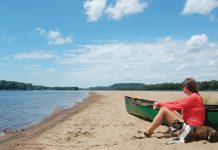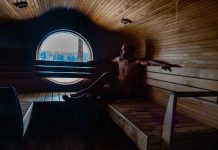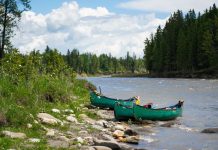I collect travel literature like book club disciples collect historic fiction, romantic murder mysteries and New York Times bestsellers.
Some of these memoirs capture the feeling and thinking of a bygone era: Steinbeck’s Travels with Charlie: In Search of America. Others offer a personal inventory of a peripatetic life’s trajectory: A Man’s Life by Mark Jenkins, Dirt Work by Christine Byl, or Smile When You’re Lying by Chuck Thompson.
Some of my favorites recall a single, momentous journey, reported with humor—Bill Bryson’s A Walk in the Woods—or heartbreak—Cheryl Strayed’s Wild—or humility—Gary Paulsen’s Winterdance.
Then there’s another rather different travel book on my shelf. Actually, it’s usually out on the table, where it wields an irresistible magnetism over houseguests: Lloyd Kahn’s Tiny Homes on the Move. The stories in this richly illustrated volume profile individuals for whom “life” and “trip” are inextricably entwined. So complete is their wanderlust, these folks have actually built their houses to travel with them.
There are artfully outfitted, meticulously crafted buses, vans, and trucks of every description. Artists whose self-described gypsy wagons are natural extensions of their creativity. There’s even an entire section devoted to floating homes on the move, including a globe-circling sailboat co-piloted by esteemed sea kayak coach and guide, Ginni Callahan.
For these nomads, “van-life” is more than a hipster hashtag plastered to every tailgate sunset pic on Instagram. It’s a way of living each day according to one’s values, of ignoring the boxes for ticking “this” or “that” and drawing a third option: both.
Recently, a friend and tripping companion told me about an exercise in which you plot your potential future trips on a sort of life calendar. All of them—a finite summation of individual adventure potential. I declined.
If the wanderers in Kahn’s book don’t distinguish between living and traveling, why should I? Sure, their tiny homes are beautiful, mobile works of art containing all that’s necessary for living in itinerant comfort. But if I pack carefully, winnowing down to only what I truly need, I have the same: my kayak.
As the late Audrey Sutherland writes in Paddling North, going on a remote kayaking trip “isn’t going away, it’s going to.” To contentment, contemplation, curiosity. To excitement, and enlightenment. It’s raising a glass to adventure.
Cheers to life on the move. Feature Photo: Virginia Marshall









I completely agree and the idea has crossed my mind. It originally surfaced in 2012 when I had the thought of living on the PCT. It is a 6 month through hike. I could hike up, then down. But what if it was home? What if I live on
I could sell everything, buy what I needed to live a minimalist life off the grid. I was a writer so as long as I had internet access it could work. I would publish when I could get internet access. I could also stay or work in towns as I saw fit (or if I needed the income). When I got into sea kayaking, this idea came up again, the PCT being replaced with the the Cascadia Marine Trails.
There is no doubt it is doable and quite possibly, an amazing way to live. Kayaking would provide access to more exploration. An occasional ride to a new locale and it’s back on the water.
I like this article. I always get a little nervous when I’m far from home on the water, for fear something will go wrong there. This is a better attitude.
You look familiar.
You ever teach at greenland camp or paddlepalooza with james and Dympna?